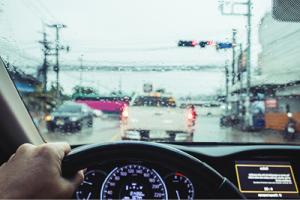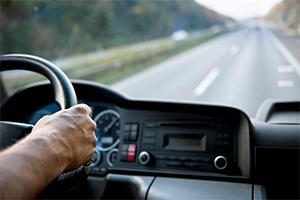Prevent vehicle backing accidents
The U.S. Department of Transportation has estimated that almost half a million vehicle backing accidents occur each year, even though virtually all of these crashes could have been prevented. The following information is intended to help drivers avoid backing accidents, through awareness of the hazards involved, and knowledge of the techniques that can be used to prevent them.
The hazards of backing up
Backing is performed so often that operators may become complacent to the special hazards involved.
The hazards of backing up include:
- Limited visibility of the area behind the vehicle
- The steering wheels are no longer the lead wheels
- Steering response can be quick and exaggerated
- Moving the steering wheel while backing provides an opposite vehicle reaction, as compared to when traveling forward
- Vehicle and trailer combinations can be more difficult to maneuver in reverse
Tips on backing
The best way to avoid backing hazards is to avoid backing up altogether. Maneuver the vehicle so that it does not have to be backed in or out. If that’s not possible, operators should consider the following:
- Scrutinize the area behind and around the vehicle. Make sure that a clear view is provided.
- Safely park then exit the vehicle. Check the intended path of travel for obstructions (posts, fences, power and communication lines, utility poles, pot holes, uneven surfaces, etc.).
- If obstructions are present, check for adequate clearances (width, height, length).
- If the vehicle must be turned while backing, position the vehicle so that the turn is made on the driver’s side, allowing for a better view.
- Use a competent ground guide to assist, but remember that doing so never relieves you of the responsibility of backing up.
- If using a ground guide, have the guide stand away from the vehicle on the driver’s side, in a position with a clear view, that allows for good communication.
- The operator should frequently check both mirrors while backing, but should never rely on mirrors alone.
- Proceed slowly. Back up no farther than absolutely necessary.
- Use your horn and four-way flashers.
- If anyone or anything enters your blind spot, stop and do not move until you see him, her or it reappears.
- Make every attempt to avoid having to back into traffic.
Conclusion
Awareness is key to identifying and recognizing backing as a special hazard, requiring thought and attention to proper technique.
Operators must competently perform this essential driving task every time.
Employing proper backing procedures, and practicing when possible, will sharpen backing skills, and help to prevent backing accidents.
This material is provided for informational purposes only and does not provide any coverage or guarantee loss prevention. The examples in this material are provided as hypothetical and for illustration purposes only. The Hanover Insurance Company and its affiliates and subsidiaries (“The Hanover”) specifically disclaim any warranty or representation that acceptance of any recommendations contained herein will make any premises, or operation safe or in compliance with any law or regulation. By providing this information to you. The Hanover does not assume (and specifically disclaims) any duty, undertaking or responsibility to you. The decision to accept or implement any recommendation(s) or advice contained in this material must be made by you.
LC NOV 2018 08-67
171-0868 (10/13)
Related resources
Prevent vehicle backing accidents
The U.S. Department of Transportation has estimated that almost half a million vehicle backing accidents occur each year, even though virtually all of these crashes could have been prevented. The following information is intended to help drivers avoid backing accidents, through awareness of the hazards involved, and knowledge of the techniques that can be used to prevent them.
The hazards of backing up
Backing is performed so often that operators may become complacent to the special hazards involved.
The hazards of backing up include:
- Limited visibility of the area behind the vehicle
- The steering wheels are no longer the lead wheels
- Steering response can be quick and exaggerated
- Moving the steering wheel while backing provides an opposite vehicle reaction, as compared to when traveling forward
- Vehicle and trailer combinations can be more difficult to maneuver in reverse
Tips on backing
The best way to avoid backing hazards is to avoid backing up altogether. Maneuver the vehicle so that it does not have to be backed in or out. If that’s not possible, operators should consider the following:
- Scrutinize the area behind and around the vehicle. Make sure that a clear view is provided.
- Safely park then exit the vehicle. Check the intended path of travel for obstructions (posts, fences, power and communication lines, utility poles, pot holes, uneven surfaces, etc.).
- If obstructions are present, check for adequate clearances (width, height, length).
- If the vehicle must be turned while backing, position the vehicle so that the turn is made on the driver’s side, allowing for a better view.
- Use a competent ground guide to assist, but remember that doing so never relieves you of the responsibility of backing up.
- If using a ground guide, have the guide stand away from the vehicle on the driver’s side, in a position with a clear view, that allows for good communication.
- The operator should frequently check both mirrors while backing, but should never rely on mirrors alone.
- Proceed slowly. Back up no farther than absolutely necessary.
- Use your horn and four-way flashers.
- If anyone or anything enters your blind spot, stop and do not move until you see him, her or it reappears.
- Make every attempt to avoid having to back into traffic.
Conclusion
Awareness is key to identifying and recognizing backing as a special hazard, requiring thought and attention to proper technique.
Operators must competently perform this essential driving task every time.
Employing proper backing procedures, and practicing when possible, will sharpen backing skills, and help to prevent backing accidents.
This material is provided for informational purposes only and does not provide any coverage or guarantee loss prevention. The examples in this material are provided as hypothetical and for illustration purposes only. The Hanover Insurance Company and its affiliates and subsidiaries (“The Hanover”) specifically disclaim any warranty or representation that acceptance of any recommendations contained herein will make any premises, or operation safe or in compliance with any law or regulation. By providing this information to you. The Hanover does not assume (and specifically disclaims) any duty, undertaking or responsibility to you. The decision to accept or implement any recommendation(s) or advice contained in this material must be made by you.
LC NOV 2018 08-67
171-0868 (10/13)
Related resources
Prevent vehicle backing accidents
The U.S. Department of Transportation has estimated that almost half a million vehicle backing accidents occur each year, even though virtually all of these crashes could have been prevented. The following information is intended to help drivers avoid backing accidents, through awareness of the hazards involved, and knowledge of the techniques that can be used to prevent them.
The hazards of backing up
Backing is performed so often that operators may become complacent to the special hazards involved.
The hazards of backing up include:
- Limited visibility of the area behind the vehicle
- The steering wheels are no longer the lead wheels
- Steering response can be quick and exaggerated
- Moving the steering wheel while backing provides an opposite vehicle reaction, as compared to when traveling forward
- Vehicle and trailer combinations can be more difficult to maneuver in reverse
Tips on backing
The best way to avoid backing hazards is to avoid backing up altogether. Maneuver the vehicle so that it does not have to be backed in or out. If that’s not possible, operators should consider the following:
- Scrutinize the area behind and around the vehicle. Make sure that a clear view is provided.
- Safely park then exit the vehicle. Check the intended path of travel for obstructions (posts, fences, power and communication lines, utility poles, pot holes, uneven surfaces, etc.).
- If obstructions are present, check for adequate clearances (width, height, length).
- If the vehicle must be turned while backing, position the vehicle so that the turn is made on the driver’s side, allowing for a better view.
- Use a competent ground guide to assist, but remember that doing so never relieves you of the responsibility of backing up.
- If using a ground guide, have the guide stand away from the vehicle on the driver’s side, in a position with a clear view, that allows for good communication.
- The operator should frequently check both mirrors while backing, but should never rely on mirrors alone.
- Proceed slowly. Back up no farther than absolutely necessary.
- Use your horn and four-way flashers.
- If anyone or anything enters your blind spot, stop and do not move until you see him, her or it reappears.
- Make every attempt to avoid having to back into traffic.
Conclusion
Awareness is key to identifying and recognizing backing as a special hazard, requiring thought and attention to proper technique.
Operators must competently perform this essential driving task every time.
Employing proper backing procedures, and practicing when possible, will sharpen backing skills, and help to prevent backing accidents.
This material is provided for informational purposes only and does not provide any coverage or guarantee loss prevention. The examples in this material are provided as hypothetical and for illustration purposes only. The Hanover Insurance Company and its affiliates and subsidiaries (“The Hanover”) specifically disclaim any warranty or representation that acceptance of any recommendations contained herein will make any premises, or operation safe or in compliance with any law or regulation. By providing this information to you. The Hanover does not assume (and specifically disclaims) any duty, undertaking or responsibility to you. The decision to accept or implement any recommendation(s) or advice contained in this material must be made by you.
LC NOV 2018 08-67
171-0868 (10/13)
Related resources
Prevent vehicle backing accidents
The U.S. Department of Transportation has estimated that almost half a million vehicle backing accidents occur each year, even though virtually all of these crashes could have been prevented. The following information is intended to help drivers avoid backing accidents, through awareness of the hazards involved, and knowledge of the techniques that can be used to prevent them.
The hazards of backing up
Backing is performed so often that operators may become complacent to the special hazards involved.
The hazards of backing up include:
- Limited visibility of the area behind the vehicle
- The steering wheels are no longer the lead wheels
- Steering response can be quick and exaggerated
- Moving the steering wheel while backing provides an opposite vehicle reaction, as compared to when traveling forward
- Vehicle and trailer combinations can be more difficult to maneuver in reverse
Tips on backing
The best way to avoid backing hazards is to avoid backing up altogether. Maneuver the vehicle so that it does not have to be backed in or out. If that’s not possible, operators should consider the following:
- Scrutinize the area behind and around the vehicle. Make sure that a clear view is provided.
- Safely park then exit the vehicle. Check the intended path of travel for obstructions (posts, fences, power and communication lines, utility poles, pot holes, uneven surfaces, etc.).
- If obstructions are present, check for adequate clearances (width, height, length).
- If the vehicle must be turned while backing, position the vehicle so that the turn is made on the driver’s side, allowing for a better view.
- Use a competent ground guide to assist, but remember that doing so never relieves you of the responsibility of backing up.
- If using a ground guide, have the guide stand away from the vehicle on the driver’s side, in a position with a clear view, that allows for good communication.
- The operator should frequently check both mirrors while backing, but should never rely on mirrors alone.
- Proceed slowly. Back up no farther than absolutely necessary.
- Use your horn and four-way flashers.
- If anyone or anything enters your blind spot, stop and do not move until you see him, her or it reappears.
- Make every attempt to avoid having to back into traffic.
Conclusion
Awareness is key to identifying and recognizing backing as a special hazard, requiring thought and attention to proper technique.
Operators must competently perform this essential driving task every time.
Employing proper backing procedures, and practicing when possible, will sharpen backing skills, and help to prevent backing accidents.
This material is provided for informational purposes only and does not provide any coverage or guarantee loss prevention. The examples in this material are provided as hypothetical and for illustration purposes only. The Hanover Insurance Company and its affiliates and subsidiaries (“The Hanover”) specifically disclaim any warranty or representation that acceptance of any recommendations contained herein will make any premises, or operation safe or in compliance with any law or regulation. By providing this information to you. The Hanover does not assume (and specifically disclaims) any duty, undertaking or responsibility to you. The decision to accept or implement any recommendation(s) or advice contained in this material must be made by you.
LC NOV 2018 08-67
171-0868 (10/13)





